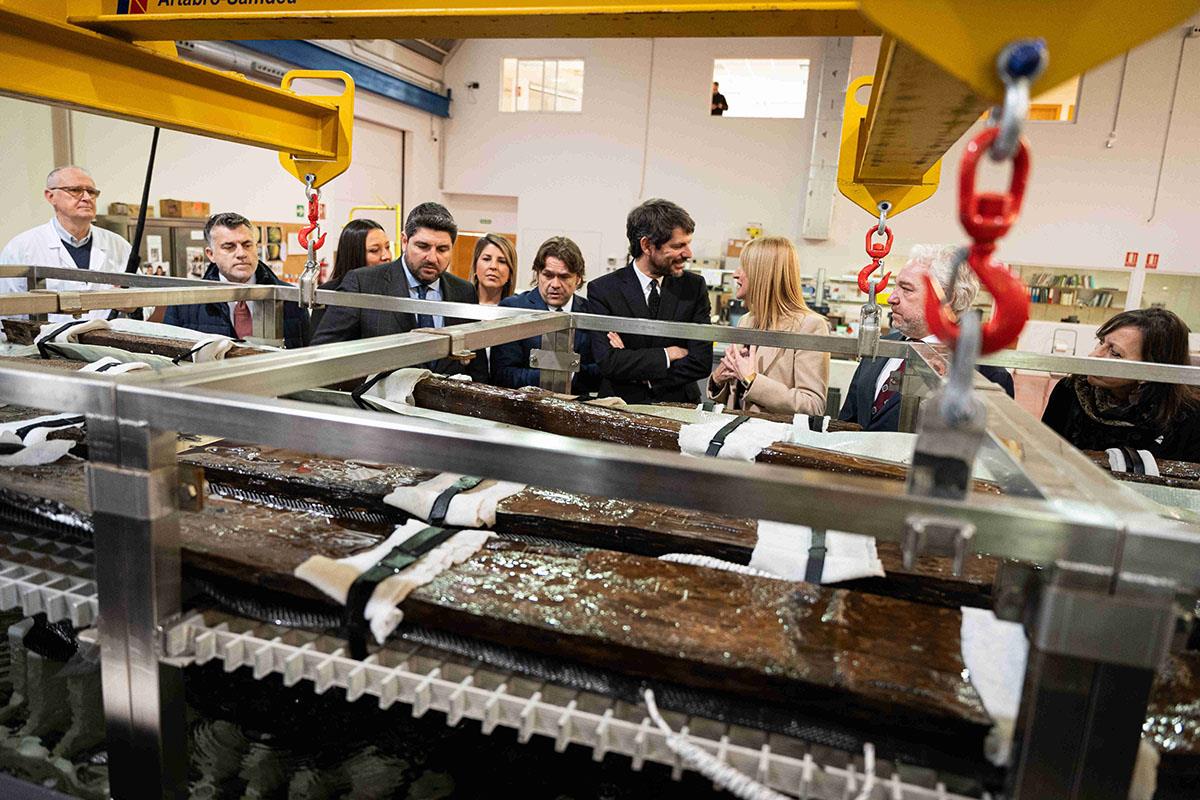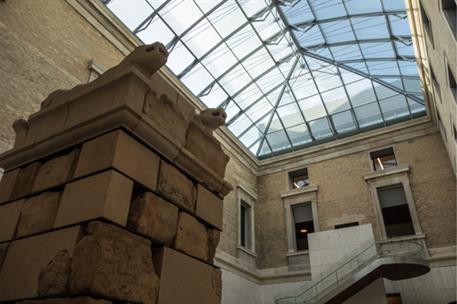The Ministry of Culture presents the consolidation work on the Phoenician shipwreck Mazarrón II at the Museum of Underwater Archaeology
News - 2025.1.16
 The Minister for Culture, Ernest Urtasun, during his visit to the laboratory of the National Museum of Underwater Archaeology
The Minister for Culture, Ernest Urtasun, during his visit to the laboratory of the National Museum of Underwater Archaeology
The Minister for Culture, Ernest Urtasun, has visited ARQVAtec, the laboratory of the National Museum of Underwater Archaeology ARQVA, in order to present the work that the Ministry of Culture is carrying out in the state museum to conserve and recover the Phoenician vessel Mazarrón II. The actions are part of the joint conservation project for this important underwater heritage that is being undertaken by the Ministry of Culture and the Government of the Region of Murcia, defined after the meeting of international experts that decided to extract the remains of the ship to ensure its conservation.
Once the extraction process was completed, carried out between September and November 2024 by the Region of Murcia with a team of researchers from the University of Valencia, the Ministry of Culture - which has also collaborated in the recovery - has taken on the work of stabilising and consolidating the pieces deposited in ARQVAtec, one of the best and most advanced underwater archaeology laboratories in Europe and the only one recognised in the UNESCO Register of Good Practices relating to Underwater Cultural Heritage.
New equipment
To receive the fragments of the ship, ARQVAtec has reinforced its equipment with new filtering equipment and an outrigger for the distribution of loads on the frames to be handled by the bridge crane, with the aim of tackling the new project to be carried out in the coming years: the consolidation and treatment of the fragments of the wreck for its future reintegration.
The centre is already equipped with specific infrastructure to carry out conservation treatments of large batches of archaeological material or large pieces, which is common in underwater archaeology. It consists of desalination, impregnation and electrolysis treatment tanks, washing tables, cranes and elements for handling large loads and other specific equipment, which are distributed over the 1,000 square metres occupied by the laboratory.
In addition, the Ministry of Culture has invested 1.2 million euros in freeze-drying equipment to dehydrate the wood in the ship and guarantee its conservation, while respecting its integrity. The large size of the remains of the wreck has made it necessary to contract the manufacture of this equipment with the necessary size to house them and at the same time have the capacity to treat smaller and more delicate pieces.
Stabilisation, desalination and freeze-drying
In total, the whole of the Mazarrón II comprises more than twenty portions of the vessel: 13 frames (curved pieces that act as ribs), the anchor (one of the oldest surviving structural models) and some elements of the rigging, notably the line that joins the anchor to the ship, the forestay. All of them are currently in saltwater pools so that, when they are fully stabilised, they will be processed following the highest methodological, ethical and deontological standards recommended by UNESCO and the International Council of Museums (ICOM).
The process, which will take several years, will begin with the desalination of the timbers, using periodic freshwater baths. Subsequently, the water that impregnates the wood will be replaced by a synthetic material (polyethylene glycol-PEG) that will provide the lost resistance, while maintaining its appearance, texture and colour. The final step will be freeze-drying, a process that consists of drying the previously frozen pieces by sublimation, i.e. from ice to vapour without passing through liquid. Once the pieces have stabilised, they can be assembled and mounted for future museum use.
This intervention represents a unique opportunity to further knowledge of nautical archaeology and the processes of conservation and restoration of waterlogged timbers.
A seventh-century BCE ship and its cargo
The discovery of Mazarrón II, dated to the second half of the seventh century BCE or the first half of the sixth century BCE, documents in an exceptional way the maritime route of metal exploitation derived from the Phoenician presence in the Iberian Peninsula. This site, consisting of the almost complete ship and its cargo, provides an exceptional insight into shipbuilding, life on board, the stowage and crowding system, and the oldest surviving use of built anchors.
Until now, the wreck had been preserved 'in situ' on the site covered by a metal box, but the changing environmental conditions, influenced by climate change and frequent DANA, endangered its stability and made it essential to remove it to ensure its preservation.
Therefore, in May 2022, following the organisation by the Ministry of Culture, in collaboration with the Region of Murcia, of the 'International Meeting of Experts on the extraction and conservation of the ship Mazarrón II', in which specialists in the field and representatives of all the administrations took part, it was agreed, following the technical criteria of this working group, to extract the different pieces into which the ship was already fragmented so that they could be subsequently treated and conserved in the ARQVAtec laboratory.
The project to recover the wreck has had the collaboration of the Ministry of Culture, through the Directorate General of Cultural Heritage and Fine Arts and the National Museum of Underwater Archaeology ARQVA, through the loan of materials and equipment and the advice of its technicians and curators.
Non official translation





